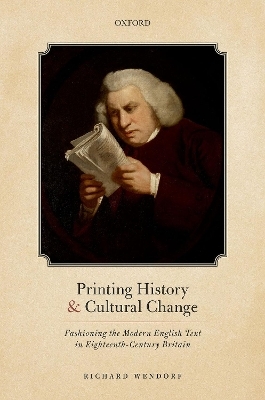
Printing History and Cultural Change
Fashioning the Modern English Text in Eighteenth-Century Britain
Seiten
2022
Oxford University Press (Verlag)
978-0-19-289813-5 (ISBN)
Oxford University Press (Verlag)
978-0-19-289813-5 (ISBN)
Explores printing conventions in the eighteenth century and the gradual tendency to abandon the use of capital letters, italics, and small capitals in English books, heralding the advent of a cleaner, and smoother, printed page. It studies a range of texts and the changing roles of authors, booksellers, printers, and the reading public.
This study provides one of the most detailed and comprehensive examinations ever devoted to a critical transformation in the material substance of the printed page; it carries out this exploration in the history of the book, moreover, by embedding these typographical changes in the context of other cultural phenomena in eighteenth-century Britain.
The gradual abandonment of pervasive capitalization, italics, and caps and small caps in books printed in London, Dublin, and the American colonies between 1740 and 1780 is mapped in five-year increments which reveal that the appearance of the modern page in English began to emerge around 1765. This descriptive and analytical account focuses on poetry, classical texts, Shakespeare, contemporary plays, the novel, the Bible, the Book of Common Prayer, sermons and religious writings, newspapers, magazines, anthologies, government publications, and private correspondence; it also examines the reading public, canon formation, editorial theory and practice, and the role of typography in textual interpretation. These changes in printing conventions are then compared to other aspects of cultural change: the adoption of the Gregorian calendar in 1752, the publication of Johnson's Dictionary in 1755, the transformation of shop signs and the imposition of house numbers in London beginning in 1762, and the evolution of the English language and of English prose style. This study concludes that this fundamental shift in printing conventions was closely tied to a pervasive interest in refinement, regularity, and standardization in the second half of the century--and that it was therefore an important component in the self-conscious process of modernizing British culture.
This study provides one of the most detailed and comprehensive examinations ever devoted to a critical transformation in the material substance of the printed page; it carries out this exploration in the history of the book, moreover, by embedding these typographical changes in the context of other cultural phenomena in eighteenth-century Britain.
The gradual abandonment of pervasive capitalization, italics, and caps and small caps in books printed in London, Dublin, and the American colonies between 1740 and 1780 is mapped in five-year increments which reveal that the appearance of the modern page in English began to emerge around 1765. This descriptive and analytical account focuses on poetry, classical texts, Shakespeare, contemporary plays, the novel, the Bible, the Book of Common Prayer, sermons and religious writings, newspapers, magazines, anthologies, government publications, and private correspondence; it also examines the reading public, canon formation, editorial theory and practice, and the role of typography in textual interpretation. These changes in printing conventions are then compared to other aspects of cultural change: the adoption of the Gregorian calendar in 1752, the publication of Johnson's Dictionary in 1755, the transformation of shop signs and the imposition of house numbers in London beginning in 1762, and the evolution of the English language and of English prose style. This study concludes that this fundamental shift in printing conventions was closely tied to a pervasive interest in refinement, regularity, and standardization in the second half of the century--and that it was therefore an important component in the self-conscious process of modernizing British culture.
Richard Wendorf has been Director of the American Museum & Gardens since 2010. Previously he was Professor of English and Art History at Northwestern University, Librarian of the Houghton Library and Senior Lecturer on the Fine Arts at Harvard University, and Stanford Calderwood Director and Librarian of the Boston Athenaeum.
Part I. Abandoning the Capital
1: The Great Divide
2: Literary Texts and Collections
3: Religious Texts
4: Capitalizing the Colonies
Coda. From the Early Modern to the Modern English Page
Part II. Printing, Interpretation, and Cultural Change
5: Printers, Readers, and Writers
6: Printing and Interpretation
7: Historical Correlatives
8: Historical Explanations
Bibliography
| Erscheinungsdatum | 04.05.2022 |
|---|---|
| Zusatzinfo | 70 Illustrations |
| Verlagsort | Oxford |
| Sprache | englisch |
| Maße | 165 x 241 mm |
| Gewicht | 674 g |
| Themenwelt | Geisteswissenschaften ► Sprach- / Literaturwissenschaft ► Anglistik / Amerikanistik |
| Geisteswissenschaften ► Sprach- / Literaturwissenschaft ► Literaturgeschichte | |
| Geisteswissenschaften ► Sprach- / Literaturwissenschaft ► Literaturwissenschaft | |
| ISBN-10 | 0-19-289813-2 / 0192898132 |
| ISBN-13 | 978-0-19-289813-5 / 9780192898135 |
| Zustand | Neuware |
| Haben Sie eine Frage zum Produkt? |
Mehr entdecken
aus dem Bereich
aus dem Bereich
Poetik eines sozialen Urteils
Buch | Hardcover (2023)
De Gruyter (Verlag)
CHF 83,90
Buch | Softcover (2024)
belleville (Verlag)
CHF 27,95


